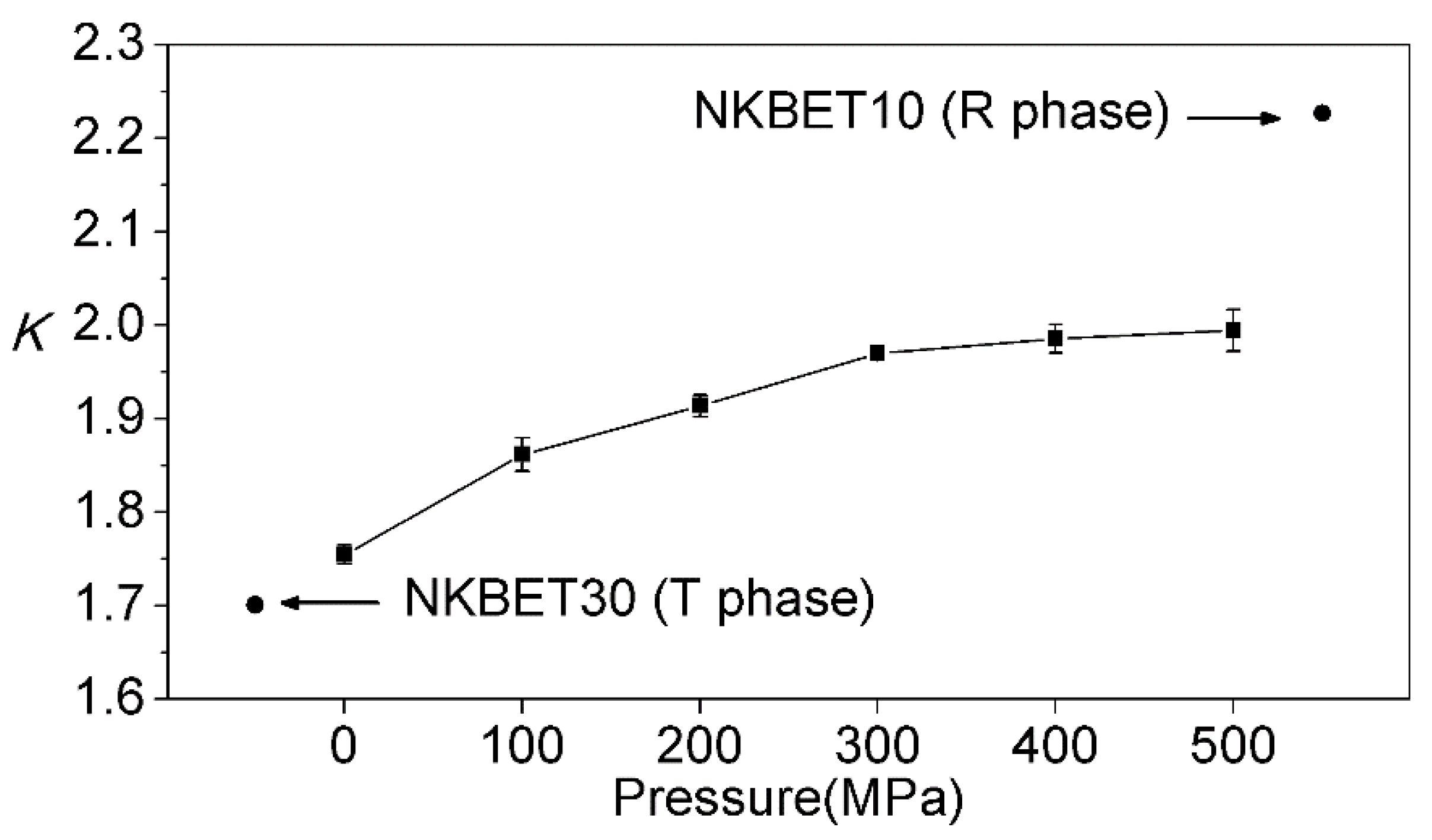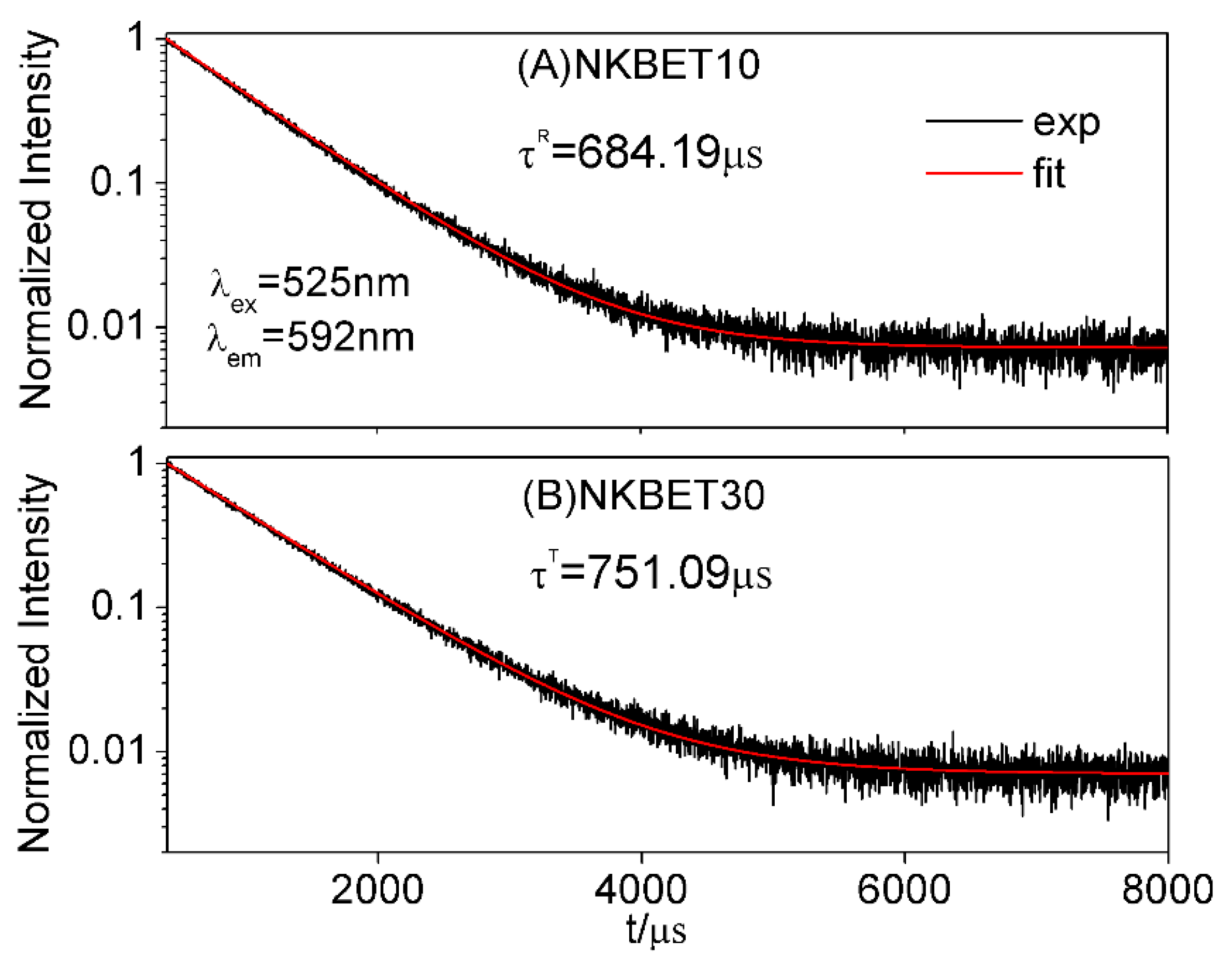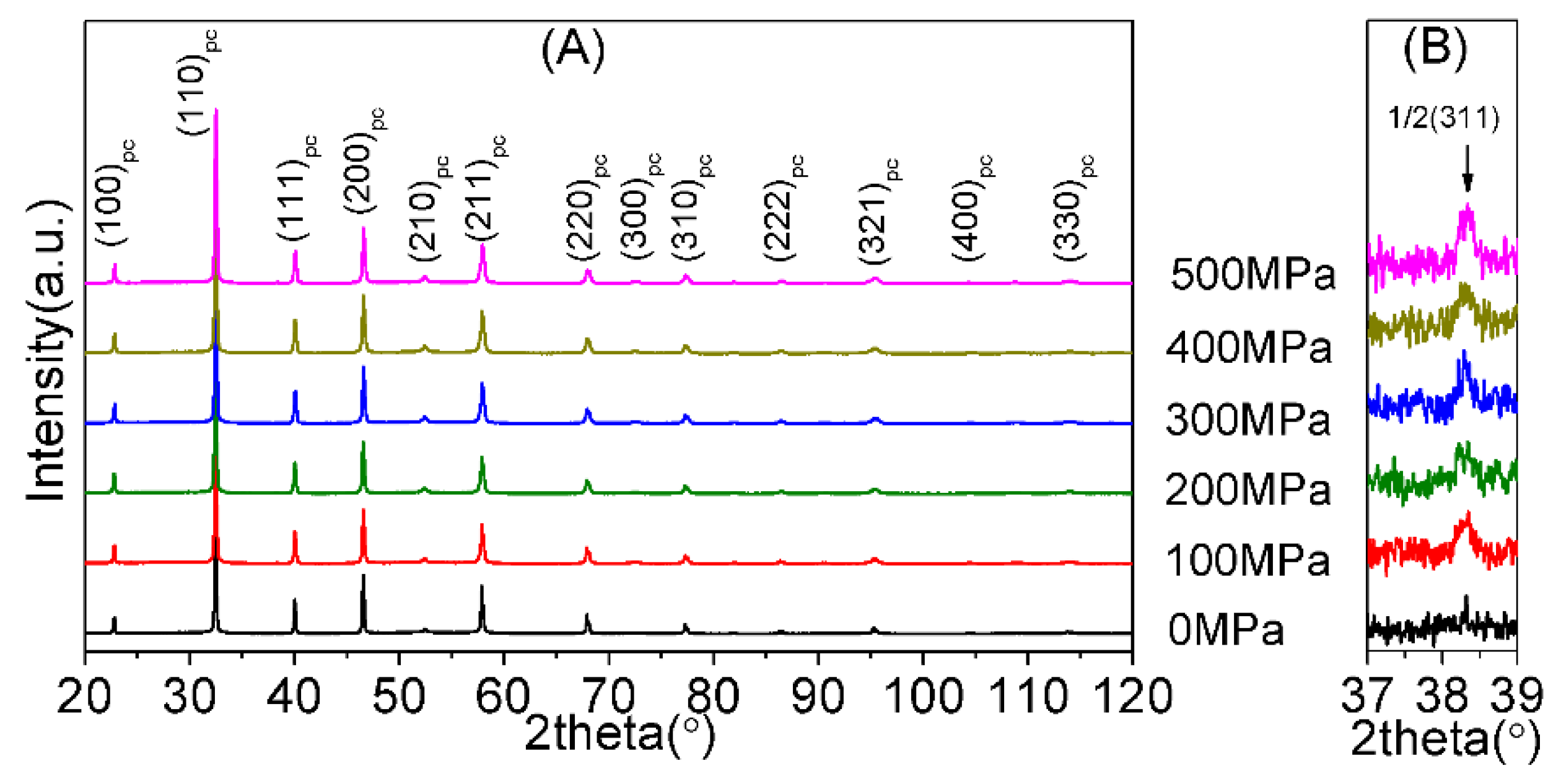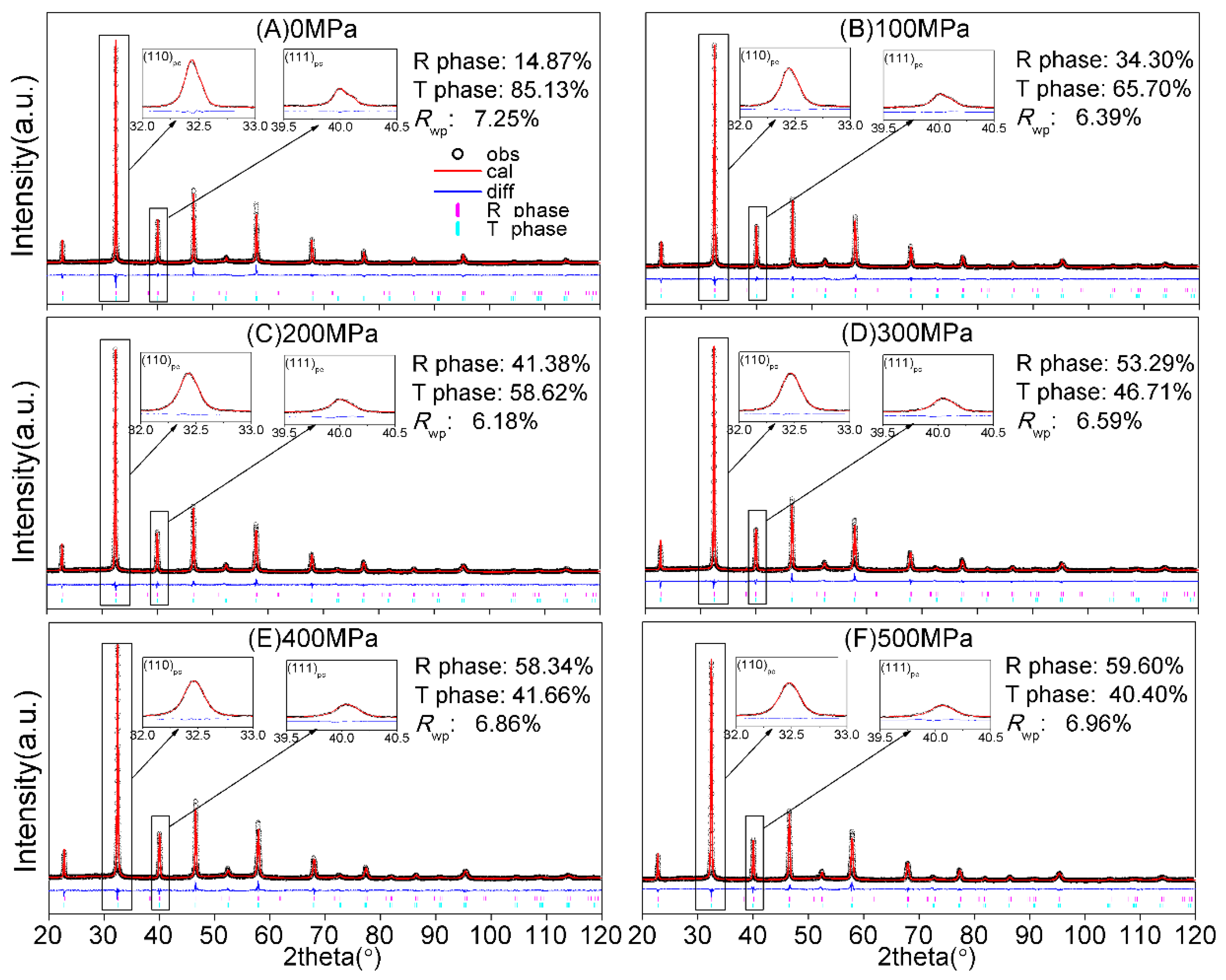Quantitatively Analyzing Pressure Induced Phase Transformation by Photoluminescence Spectra in Eu3+-doped Sodium Potassium Bismuth Titanate
Abstract
:1. Introduction
2. Materials and Methods
3. Results and Discussions
4. Conclusions
Author Contributions
Funding
Conflicts of Interest
References
- Chen, C.; Liang, R.; Zhou, Z.; Nie, X.; Zhang, W.; Cao, F.; Dong, X. Evaluation of Domain Wall Motion in Mn-Doped PMS-PZT Ceramics under Various Hydrostatic Pressures by Nonlinear Response Measurements. Ceram. Int. 2018, 44, 10215–10219. [Google Scholar] [CrossRef]
- Liu, Z.; Ren, W.; Nie, H.; Peng, P.; Liu, Y.; Dong, X.; Cao, F.; Wang, G. Pressure Driven Depolarization Behavior of Bi0.5Na0.5TiO3 Based Lead-Free Ceramics. Appl. Phys. Lett. 2017, 110, 212901. [Google Scholar] [CrossRef]
- Hall, D.; Evans, J.; Covey-Crump, S.; Holloway, R.; Oliver, E.; Mori, T.; Withers, P. Effects of Superimposed Electric Field and Porosity on the Hydrostatic Pressure-Induced Rhombohedral to Orthorhombic Martensitic Phase Transformation in PZT 95/5 Ceramics. Acta Mater. 2010, 58, 6584–6591. [Google Scholar] [CrossRef]
- Gao, J.; Xu, Z.; Zhang, C.; Wei, X.; Yao, X.; Li, F. Hydrostatic Pressure Dependence of Dielectric, Elastic, and Piezoelectric Properties of Pb(Mg1/3Nb2/3)O3-0.33PbTiO3 Ceramic. J. Am. Ceram. Soc. 2011, 94, 2946–2950. [Google Scholar] [CrossRef]
- Basu, A.; Jana, R.; Mandal, G.; Chandra, A.; Mukherjee, G.D. Pressure Driven Ferroelectric to Paraelectric Transition in Sr Doped BaTiO3. J. Appl. Phys. 2015, 117, 054102. [Google Scholar] [CrossRef]
- Nie, H.; Su, R.; Peng, P.; Cao, F.; Liu, Y.; He, H.; Wang, G.; Dong, X.; Fei, C.; Hongliang, H. Pressure-induced Phase Transitions in PZ-X BMN Binary Solid Solutions. J. Am. Ceram. Soc. 2019, 102, 4021–4028. [Google Scholar] [CrossRef]
- Peng, P.; Nie, H.; Guo, W.; Cao, F.; Wang, G.; Dong, X. Pressur-induced ferroelectri-relaxor phase transition in (Bi0.5Na0.5)TiO3-based ceramics. J. Am. Ceram. Soc. 2019, 102, 2569–2577. [Google Scholar]
- Hagiwara, M.; Ehara, Y.; Novak, N.; Khansur, N.H.; Ayrikyan, A.; Webber, K.G.; Fujihara, S. Relaxor-Ferroelectric Crossover in (Bi1/2K1/2)TiO3: Origin of the Spontaneous Phase Transition and the Effect of an Applied External Field. Phys. Rev. B 2017, 96, 014103. [Google Scholar] [CrossRef]
- Schader, F.H.; Wang, Z.; Hinterstein, M.; Daniels, J.E.; Webber, K.G. Stress-modulated relaxor-to-ferroelectric transition in lead-free (Na1/2Bi1/2)TiO3-BaTiO3 ferroelectrics. Phys. Rev. B 2016, 93, 134111. [Google Scholar] [CrossRef] [Green Version]
- Lee, G.; Shin, D.-J.; Kwon, Y.-H.; Jeong, S.-J.; Koh, J.-H. Optimized Piezoelectric and Structural Properties of (Bi,Na)TiO3–(Bi,K)TiO3 Ceramics for Energy Harvester Applications. Ceram. Int. 2016, 42, 14355–14363. [Google Scholar] [CrossRef]
- Khansur, N.H.; Benton, R.; Dinh, T.H.; Lee, J.-S.; Jones, J.L.; Daniels, J.E. Composition Dependence of Electric-Field-Induced Structure of Bi1/2(Na1−xKx)1/2TiO3 Lead-Free Piezoelectric Ceramics. J. Appl. Phys. 2016, 119, 234101. [Google Scholar] [CrossRef]
- Butnoi, P.; Manotham, S.; Jaita, P.; Pengpat, K.; Eitssayeam, S.; Tunkasiri, T.; Rujijanagul, G. Effects of Processing Parameter on Phase Transition and Electrical Properties of Lead-Free BNKT Piezoelectric Ceramics. Ferroelectr. 2017, 511, 42–51. [Google Scholar] [CrossRef]
- Otoničar, M.; Škapin, S.; Spreitzer, M.; Suvorov, D. Compositional Range and Electrical Properties of the Morphotropic Phase Boundary in the Na0.5Bi0.5TiO3–K0.5Bi0.5TiO3 System. J. Eur. Ceram. Soc. 2010, 30, 971–979. [Google Scholar] [CrossRef]
- Yang, Z.; Liu, B.; Wei, L.; Hou, Y. Structure and Electrical Properties of (1−x)Bi0.5Na0.5TiO3–xBi0.5K0.5TiO3 Ceramics Near Morphotropic Phase Boundary. Mater. Res. Bull. 2008, 43, 81–89. [Google Scholar] [CrossRef]
- Sasaki, A.; Chiba, T.; Mamiya, Y.; Otsuki, E. Dielectric and Piezoelectric Properties of (Bi0.5Na0.5)TiO3–(Bi0.5K0.5)TiO3 Systems. Jpn. J. Appl. Phys. 1999, 38, 5564–5567. [Google Scholar] [CrossRef]
- Hao, X.; Zhai, J.; Kong, L.B.; Xu, Z. A comprehensive review on the progress of lead zirconate-based antiferroelectric materials. Prog. Mater. Sci. 2014, 63, 1–57. [Google Scholar] [CrossRef]
- Royles, A.J.; Bell, A.; Jephcoat, A.P.; Kleppe, A.K.; Milne, S.J.; Comyn, T.P. Electric-Field-Induced Phase Switching in the Lead Free Piezoelectric Potassium Sodium Bismuth Titanate. Appl. Phys. Lett. 2010, 97, 132909. [Google Scholar] [CrossRef]
- He, J.; Zhang, J.; Xing, H.; Pan, H.; Jia, X.; Wang, J.; Zheng, P. Thermally Stable Ferroelectricity and Photoluminescence in Sm-Doped 0.8(Bi0.5Na0.5)TiO3-0.2SrTiO3 Ferroelectric Ceramics. Ceram. Int. 2017, 43, 250–255. [Google Scholar] [CrossRef]
- Wu, X.; Lin, J.; Chen, P.; Liu, C.; Lin, M.; Lin, C.; Luo, L.; Zheng, X. Ho3+-doped (K,Na)NbO3-based multifunctional transparent ceramics with superior optical temperature sensing performance. J. Am. Ceram. Soc. 2019, 102, 1249–1258. [Google Scholar] [CrossRef]
- Sukul, P.P.; Kumar, K.; Swart, H.C. Photoluminescence spectroscopy of Eu3+: An economical technique for the detection of crystal phase transformation in PbZr0.53Ti0.47O3 ceramics. OSA Continuum. 2018, 1, 971. [Google Scholar] [CrossRef]
- Xiang, X.J.X.; Chen, C.; Tu, N.; Chen, Y.; Li, X.; Wang, P.; Fan, G. Composition and poling-induced modulation on photoluminescence properties for NBT-xBT: Pr3+ ceramics. J. Eur. Ceram. Soc. 2018, 38, 1498–1507. [Google Scholar]
- Du, P.; Luo, L.; Li, W.; Yue, Q. Upconversion Emission in Er-Doped and Er/Yb-Codoped Ferroelectric Na0.5Bi0.5TiO3 and Its Temperature Sensing Application. J. Appl. Phys. 2014, 116, 14102. [Google Scholar] [CrossRef]
- Du, P.; Luo, L.; Li, W.; Zhang, Y.; Chen, H. Photoluminescence and Piezoelectric Properties of Pr-Doped NBT–xBZT Ceramics: Sensitive to Structure Transition. J. Alloy. Compd. 2013, 559, 92–96. [Google Scholar] [CrossRef]
- Khatua, D.K.; Agarwal, A.; Kumar, N.; Ranjan, R. Probing Local Structure of the Morphotropic Phase Boundary Composition of Na0.5Bi0.5TiO3–BaTiO3 Using Rare-Earth Photoluminescence as a Technique. Acta Mater. 2018, 145, 429–436. [Google Scholar] [CrossRef]
- Zhang, P.; Shen, M.; Fang, L.; Zheng, F.; Wu, X.; Shen, J.; Chen, H. Pr3+ photoluminescence in ferroelectric (Ba0.77Ca0.23)TiO3 ceramics: Sensitive to polarization and phase transitions. Appl. Phys. Lett. 2008, 92, 222908. [Google Scholar] [CrossRef]
- Yao, Y.; Luo, L.; Li, W.; Zhou, J.; Wang, F. An intuitive method to probe phase structure by upconversion photoluminescence of Er3+ doped in ferroelectric Pb(Mg1/3Nb2/3)O3-PbTiO3. Appl. Phys. Lett. 2015, 106, 082906. [Google Scholar] [CrossRef]
- Zeng, L.; Zhou, J. Quantitative phase analyses of Eu3+-doped (Na1−x,Kx)0.5Bi0.5TiO3 ferroelectric ceramics near morphotropic phase boundary by photoluminescence spectra. Ceram. Int. 2019, 45, 15913–15919. [Google Scholar] [CrossRef]
- Görller-Walrand, C.; Fluyt, L.; Ceulemans, A.; Carnall, W.T. Magnetic Dipole Transitions as Standards for Judd–Ofelt Parametrization in Lanthanide Spectra. J. Chem. Phys. 1991, 95, 3099–3106. [Google Scholar] [CrossRef]
- Binnemans, K. Interpretation of europium (III) Spectra. Co-ord. Chem. Rev. 2015, 295, 1–45. [Google Scholar] [CrossRef] [Green Version]
- Abhijeet, B.N.R.K.; Thomas, T.; Ranjan, R. Electric field induced short range to long range structural ordering and its influence on the Eu+3 photoluminescence in the lead-free ferroelectric Na1/2Bi1/2TiO3. J. Appl. Phys. 2015, 117, 244106. [Google Scholar]
- Glazer, A.M. Simple ways of determining perovskite structures. Acta Cryst. A 1975, 31, 756–762. [Google Scholar] [CrossRef] [Green Version]
- Glazer, A.M. The classification of tilted octahedra in perovskites. Acta Cryst. B 1972, 28, 3384–3392. [Google Scholar] [CrossRef]
- Jones, G.O.; Thomas, P.A. Investigation of the structure and phase transitions in the novel A-site substituted distorted perovskite compound Na0.5Bi0.5TiO3. Acta Cryst. B 2002, 58, 168–178. [Google Scholar] [CrossRef] [PubMed] [Green Version]
- Adhikary, G.D.; Khatua, D.K.; Senyshyn, A.; Ranjan, R. Long-Period Structural Modulation on the Global Length Scale As the Characteristic Feature of the Morphotropic Phase Boundaries in the Na0.5Bi0.5TiO3 Based Lead-Free Piezoelectrics. Acta Mater. 2019, 164, 749–760. [Google Scholar] [CrossRef]
- Ranjan, R.; Dviwedi, A. Structure and Dielectric Properties of (Na0.50Bi0.50)1−xBaxTiO3: 0 ≤ x ≤ 0.10. Solid State Commun. 2005, 135, 394–399. [Google Scholar] [CrossRef]
- Toby, B.H. EXPGUI, a Graphical User Interface for GSAS. J. Appl. Crystallogr. 2001, 34, 210–213. [Google Scholar] [CrossRef] [Green Version]
- Larson, A.C.; Dreele, R.B.V. General Structure Analysis System (GSAS); Los Alamos National Laboratory Report LAUR; Los Alamos National Laboratory: Los Alamos, NM, USA, 2000; pp. 86–748. [Google Scholar]
- Jones, G.O.; Kreisel, J.; Thomas, P.A. A Structural Study of the (Na1−xKx)0.5Bi0.5TiO3 Perovskite Series as a Function of Substitution (x) and Temperature. Powder Diffr. 2002, 17, 301–319. [Google Scholar] [CrossRef]
- Avdeev, M.; Jorgensen, J.D.; Short, S.; Samara, G.A.; Venturini, E.L.; Yang, P.; Morosin, B. Pressure-induced ferroelectric to antiferroelectric phase transition in Pb0.99(Zr0.95Ti0.05)0.98Nb0.02O3. Phys. Rev. B 2006, 73, 064105. [Google Scholar] [CrossRef]
- Comyn, T.P.; Stevenson, T.; Al-Jawad, M.; Marshall, W.G.; Smith, R.I.; Herrero-Albillos, J.; Cywinski, R.; Bell, A.J. Pressure Induced Para-Antiferromagnetic Switching in BiFeO3–PbTiO3 As Determined Using in-Situ Neutron Diffraction. J. Appl. Phys. 2013, 113, 183910. [Google Scholar] [CrossRef] [Green Version]






| P (MPa) | R3c | P4mm | R Factors | |||||||
|---|---|---|---|---|---|---|---|---|---|---|
| a (Å) | c (Å) | V (Å3) | vol% | a (Å) | c (Å) | V(Å3) | vol% | Rwp% | Rp% | |
| 0 | 5.5170 | 13.5200 | 356.377 | 14.87 | 3.9032 | 3.9111 | 59.586 | 85.13 | 7.25 | 5.73 |
| 100 | 5.5167 | 13.5171 | 356.263 | 34.30 | 3.9031 | 3.9100 | 59.566 | 65.70 | 6.39 | 4.95 |
| 200 | 5.5162 | 13.5137 | 356.116 | 41.38 | 3.9029 | 3.9096 | 59.555 | 58.62 | 6.18 | 4.79 |
| 300 | 5.5150 | 13.5133 | 355.946 | 53.29 | 3.9029 | 3.9092 | 59.548 | 46.71 | 6.59 | 5.06 |
| 400 | 5.5145 | 13.5135 | 355.892 | 58.34 | 3.9023 | 3.9079 | 59.514 | 41.66 | 6.86 | 5.28 |
| 500 | 5.5139 | 13.5129 | 355.798 | 59.60 | 3.9021 | 3.9071 | 59.490 | 40.40 | 6.96 | 5.26 |
© 2020 by the authors. Licensee MDPI, Basel, Switzerland. This article is an open access article distributed under the terms and conditions of the Creative Commons Attribution (CC BY) license (http://creativecommons.org/licenses/by/4.0/).
Share and Cite
Zeng, L.; Zhou, J. Quantitatively Analyzing Pressure Induced Phase Transformation by Photoluminescence Spectra in Eu3+-doped Sodium Potassium Bismuth Titanate. Materials 2020, 13, 881. https://doi.org/10.3390/ma13040881
Zeng L, Zhou J. Quantitatively Analyzing Pressure Induced Phase Transformation by Photoluminescence Spectra in Eu3+-doped Sodium Potassium Bismuth Titanate. Materials. 2020; 13(4):881. https://doi.org/10.3390/ma13040881
Chicago/Turabian StyleZeng, Liang, and Ji Zhou. 2020. "Quantitatively Analyzing Pressure Induced Phase Transformation by Photoluminescence Spectra in Eu3+-doped Sodium Potassium Bismuth Titanate" Materials 13, no. 4: 881. https://doi.org/10.3390/ma13040881





